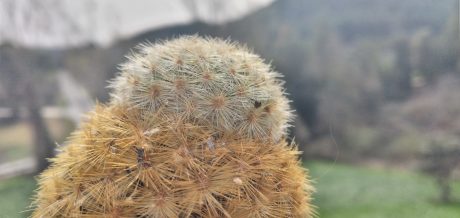Here is Mammillaria Carmenae, located between Victoria City and Tamaulipas in Mexico and part of North America. It is named after its discoverer, Marcelino Castañeda in 1953 near the La Reixa Ranch.
It is a small, solitary cactus or sometimes grouped with globous and ovoidal stems four to ten centimeters high by three to five in diameter. We can see that it has around a hundred smooth, fine, flexible cream-colored radial spines, white or a pale yellow, star-shaped and up to five millimeters long. It has no central spines and we can also see that it has woolly tubers.
The flowers of this biznaga are generally diurnal, from creamy white to pink to pale pink with central nerves dyed pink. They can be up to eleven millimeters long. Primarily, they will begin to flower from late winter to late spring, offering a very generous flowering, so, which will cost you very much not to see a flower of this specimen throughout the season. When the flower is marred, it gives way to the fruits that are greenish and act followed, we can remove the seeds, which are black.
I tell you that despite the considerable hybridization of this species in specialized nurseries, not all plants that make the flower pink are necessarily hybrid, as some species that make the flower pink actually exist in nature.
Its proper location is on the outside, in full sun or in the shadow of the afternoon. Inside, it needs bright light and some direct sun, it can be placed on the balcony or window where more hours of direct radiation touches. Good lighting is important for keeping colorful and tight spines.
It needs abundant irrigation, especially in summer, once a week is enough, in spring you can water once every fortnight and in autumn, if you are in a dry zone, once a month. In winter, stop irrigating. Before irrigating again, we must ensure that the substrate is completely dry, because if we overwhelm it, we will cause root stinking and this will lead to death.
Finally, this cactus is quite resistant to frost, if it is kept dry and without much moisture, it resists temperatures as low as five degrees negative. It’s not appropriate to go to these extremes, so if you don’t put it at less than five positive degrees, you don’t have to have much trouble making this beautiful mammillaria specimen live.









Reviews
There are no reviews yet.